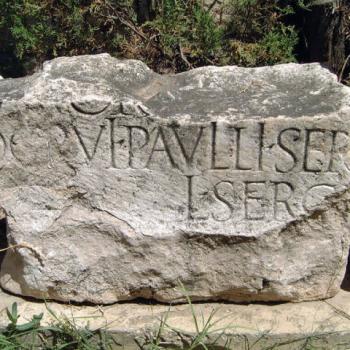(Here’s a fine reminder of the value of the voluminous work of Martin Hengel. See what you think. BW3).
New Testament Chronology and Christian Origins
by larry hurtado
In the course of writing an essay this past week in which I’m trying to work up a conceptual model for early Christianity, I had occasion to read again Martin Hengel’s pithy gem-essay: “Christology and New Testament Chronology,” in his book, Between Jesus and Paul (London: SCM, 1983), 30-47. Since grad students and other serious readers have often asked for suggestions of essential-reading items, Hengel’s essay would be prominent among them to my mind.
This essay lays out some very important basic facts, particularly chronological facts about earliest Christianity, emphasizing that the time-window for crucial developments (especially christological ones) was remarkably small. The essay appeared originally in German in 1972, the form in which I first read it (waaay back in the late 70s), but, though the discussion refers to works of that period and earlier, the issues and the points Hengel makes so pithily remain crucial.
“Crucial” but often overlooked still, even by some scholars. As Hengel put it (in his usual peppery style), “If we look through some works on the history of earliest Christianity we might get the impression that people in them had declared war on chronology” (p. 39). Here are a few of his points.
Paul’s letters (which date from ca. 50-60 CE), including notably Romans (addressed to a “pre-Pauline” Christian community), already reflect a developed christology, and do not indicate any real development across the years in which they were composed, the maximum period for the christological development reflected in the letters can be no more than ca. 18 years, “a short space of time for such an intellectual process” (39). Or, to cite another memorable statement: “In essentials more happened in christology within these few years than in the whole subsequent seven hundred years of church history” (39-40).
This christological development took place above all in Jewish-Christian communities in Jerusalem, Caesarea, Damascus, Antioch and other places in Syria and Roman Palestine, involving both Greek-speaking and Aramaic-speaking believers.
It is dubious, thus, to employ the multi-layered schemes of the old History-of-Religions scholars or the modified versions put out in the 60s and 70s, involving “Primitive Palestinian”, “Hellenistic-Jewish”, and “Hellenistic-Gentile” stages of development, all of these sometimes posited as preceding Paul’s “conversion”.
Speaking of Paul’s “conversion”, which likely must be placed within at most a couple of years subsequent to Jesus’ execution, we have to consider that an “enormously rapid christological development” took place within this even shorter period. Paul’s characterization of the cognitive content of his religious re-orientation is that it was a “revelation of God’s Son”. But, since he then promptly associated himself with other Jewish Christians (including Peter/Cephas, per Gal. 1), the most reasonable inference is that the christological view he adopted was pretty much what he had been opposing. And that means that some pretty powerful developments must be dated within the very first few years!
Given this tight chronology, it is also dubious to ascribe much to any supposed influence of pagan religious ideas and practices on these early christological developments. It requires a strong necessity to ignore chronology, and some implausible assumptions about psychology too, to posit, for example, that early Jewish Christians were somehow unconsciously disposed to treat Jesus as bearing divine-like honour through the subtle influence of pagan ruler-cults.
But I don’t want to steal Hengel’s thunder, and would really encourage a slow and careful digestion of this essay. It was formative in my own thinking from the late 70s onward, and remains unsurpassed in so concisely laying out some crucial matters.













